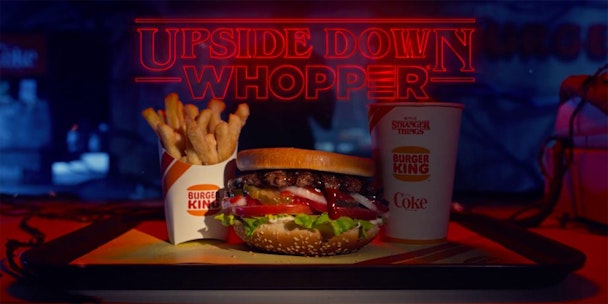Stranger Things shows that it is time to turn brand experience ‘upside down’
I’m looking at an upside-down Burger King Whopper post and scratching my head, a Shutterstock tweet nodding loosely to ‘Stranger Things in store’ *eye roll* with a limp 14 retweets and 38 likes - oh yeah, and there’s that Coke thing *insert tumbleweed here*

Time to turn brand experience ‘upside down’
Yep, we’re all talking about how Stranger Things 3 has hit screens and the proliferation of brands signing up to be part of The Upside Down. Has this flipped the sensical approach to a decent brand experience? Brand partnerships around film and content franchises are not new news; you only have to look at Disney Pixar, Bond, Marvel or Star Wars. But what I find the whopping 75 brands in promotional engagement with Netflix highlights is the often-disposable way that most brands leverage an opportunity.
On the one hand, it’s franchise genius because they’ve bridged the 80s ‘rife with blatant product placement’ era directly to cultural nostalgia that kids of the 80s, 90s and 00s so fondly look back on.
However, unlike the 80s, social media exists now, so a good brand experience is heroed and a bad one ignored (if you’re lucky). I’d love to think that if Reese’s Pieces appeared in an E.T. reboot in 2019, the brand would jump on the conversation in a much more connected way. Easy modern connectivity has perhaps bred brand laziness when it comes to jumping on whatever the latest cult craze is.
The underlying principles of good brand experience are quite simple. Firstly, know your place. Do you have an authentic ‘in’ or are you in jeopardy of looking irrelevant? Secondly, does the experience connect to culture in the right way or are you just doing it because it’s easy - or someone else did? Finally, does the experience impact culture - better yet, your shared culture - in a positive way? If you’ve got three yesses, then you’re onto a winner.
I glossed over Coke above, let’s dig into that now. New Coke was an epic fail in 1985, so much so it stayed on the market for less than 80 days so there’s a certain humour – bravery, even - in bringing it back in a parallel 2019 world. But from that first poolside sip by Mrs Wheeler and guest appearances throughout, is it relevant? It flopped so badly hardly anyone knew about it. The 2019 extended experience was disconnected and point blank didn’t work: the site went down, social outreach didn’t match availability in locations and they didn’t even turn the ‘double blunder’ on its head when it all went south on social - that’s just marketing 101.
Burger King had similar fails, with its app not working to support purchases, big noise on social and then nothing available in the stores around the corner. Levi’s launched a clothing range that couldn’t meet the minimal demand of their consumer base; H&M suffered the same fail.
OK, so it’s not quite Kendall saving the world with a Pepsi, but it is reminiscent of that awkward moment when Apple plopped U2’s album into iTunes, or perhaps Bond driving a Mondeo (WTF), Sky monetising on Lego’s equity for just a tad too long (I guess they’re both cashing in), and so on.
We have to consider where it stops being culturally relevant and starts becoming a blatant cash cow.
The bad and the ugly aside, I do quite like Eggo’s pop up spoiler alerts on Facebook and lo-fi site; it’s authentic, fun, it follows through to purchase incentives, and it works. It’s not - dare I say - over-egged. Groan. The ice cream chain Baskin-Robbins has brought fictional ice cream parlour Scoops Ahoy to life. It’s giving Stranger Things fans a physical place to interact with the show, with meticulous attention to detail in terms of making the store seem like it’s 1985. And still a fave, back in ST2, Spotify rolled out a Stranger Things mode, I loved that.
Standing the test of time, a brand partnership that has transitioned through the generational gaps for decades is Nike and Back to the Future. I have to admit to watching it for the umpteenth time recently. As an 80s child, I applauded Nike for its integral play for Air MAGs. It didn’t stop there, and has stayed connected to culture through auctions of originals, anniversary editions, an ongoing relationship with Michael J Fox and sales still coming in from MAGs old and new around the world now. MAGs themselves now have their own experience ecosystem!
Back to Stranger Things - the Nike Cortez 'Hawkins High’ online release was the first brand experience to keep track with Stranger Things general chatter until Fortnite came along (and hats off to them to with their upside-down portal maps). Nike is culturally relevant, relevantly connected, and driving positive impact.
A little nugget I found amusing in digging around in all of this is that despite the high traction from us lot in advertising, the brand conversation on social is relatively small. Of the 8.1m mentions of Stranger Things since 1 June, only 82,000 also mentioned one of the brands experiences. Admittedly, I didn’t do an exhaustive sweep across social, but I suspect the relative volume would still be negligible. It asks the question, how culturally relevant is all of this? And does it drive business?
Karen Boswell is chief experience officer EMEA at VMLY&R
